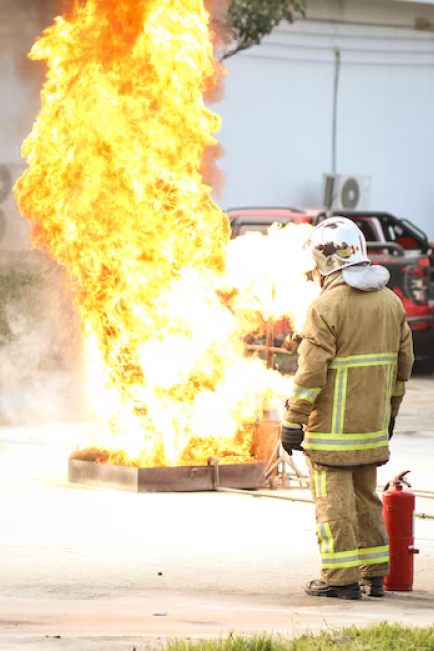Fire Training: Enhancing Fire Safety Awareness and Emergency Response
- info@safetymastery.com
- +91 7200322134


The Role of Fire Training in Promoting Workplace Safety and Preparedness
The Role of Fire Training in Promoting Workplace Safety and Preparedness
Fire training is a critical component of workplace safety, providing individuals with the knowledge, skills, and confidence to prevent fires, respond to emergencies, and protect lives and property. By investing in comprehensive fire training programs, organizations can promote a culture of safety, ensure compliance with regulations, and empower employees to take proactive measures in the event of a fire. In this comprehensive guide, we delve into the importance of fire training, essential guidelines for improving fire safety awareness, and strategies for effective emergency response in the workplace.

Safety International Diploma
- Ofqual Regulated Qualifications London, UK
- GradIOSH/CertIOSH status from IOSH, UK
- TSP status from BCSP, USA
- Gateway to MSC in UK universities
one or two years of qualification.
Get Courses Details
Get Courses Details
Safety Diploma
- Government-Endorsed National Safety Diploma Program
- Qualify for registration at the Employment Exchange
- Attestation by the Ministry of External Affairs for those wishing to move abroad
- Eligible for membership with MIIRSM (IIRSM membership at discretion)
- Approved by the Government of India
- Enhance your educational profile with an additional one or two years of qualification
Importance of Fire Training:
- Prevention and Preparedness: Fire training equips individuals with the knowledge and skills to prevent fires, identify hazards, and implement safety measures to reduce the risk of fire incidents in the workplace.
Emergency Response: Effective fire training prepares individuals to respond quickly and appropriately in the event of a fire, including evacuation procedures, fire extinguisher use, and emergency communication protocols.
Compliance and Regulations: Fire training programs ensure that organizations meet legal requirements, industry standards, and best practices for fire safety, fostering a safe and secure work environment for employees and visitors.
Risk Mitigation: By raising awareness of fire risks, providing practical training, and conducting drills and simulations, fire training helps organizations mitigate risks, prevent accidents, and protect against potential losses from fires.
Safety Culture: Fire training promotes a culture of safety, accountability, and vigilance among employees, encouraging active participation in safety programs, hazard reporting, and continuous improvement in fire safety practices.

Essential Guidelines for Fire Training:
Fire Prevention: Educate individuals on common causes of fires, fire prevention strategies, proper storage of flammable materials, housekeeping practices, and electrical safety measures to reduce fire hazards.
Emergency Procedures: Train employees on emergency response procedures, evacuation routes, assembly points, emergency contacts, and roles and responsibilities during a fire emergency.
Fire Extinguisher Training: Provide hands-on training on the types of fire extinguishers, their uses, operation techniques, and the appropriate extinguisher for different types of fires (e.g., Class A, B, C).
Evacuation Drills: Conduct regular fire drills, evacuation exercises, and simulations to practice emergency response, test evacuation procedures, and evaluate the effectiveness of evacuation plans.
Communication and Coordination: Establish clear communication channels, emergency notification systems, and protocols for reporting fires, raising alarms, and coordinating response efforts during emergencies.
Post-Fire Procedures: Train individuals on post-fire procedures, including damage assessment, safety inspections, equipment checks, and follow-up actions to ensure a safe return to normal operations after a fire incident.

Effective Emergency Response Strategies:
Stay Calm: Encourage individuals to remain calm, alert, and focused during a fire emergency, follow established procedures, and avoid panicking or making hasty decisions.
- Alert Others: Immediately notify others of the fire, activate fire alarms, alert emergency services, and alert occupants in the vicinity to evacuate the area safely.
- Evacuate Safely: Evacuate the building using designated routes, assist others in need, avoid using elevators, and move to designated assembly points to ensure a full headcount of evacuees.
Use Fire Extinguishers: If safe to do so, attempt to extinguish small fires using the appropriate fire extinguisher, following the PASS technique (Pull, Aim, Squeeze, Sweep).
- Follow Instructions: Listen to instructions from designated fire wardens, emergency response teams, and authorities, and comply with evacuation orders, safety directives, and emergency procedures.

Fire training is a fundamental element of workplace safety, ensuring that individuals are prepared to prevent fires, respond effectively to emergencies, and protect themselves and others in the event of a fire incident. By prioritizing fire training, organizations can promote a culture of safety, enhance emergency preparedness, and minimize the impact of fires on personnel, property, and operations. Remember: investing in comprehensive fire training programs, continuous education, and regular drills is key to fostering a safe, resilient, and prepared workforce capable of handling fire emergencies with confidence and competence.
